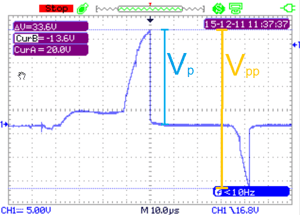Q1. Are there any widely accepted ways to quantify the degree of electrical damage a bearing has sustained?
A1. You would have to do vibration analysis and monitor the spectrum over time, as illustrated to the right. Vibration analysis can also, of course, detect other types of damage. Fluting from electrical bearing damage has a well-known vibrational profile. That is, well-known to vibration analysts; less so to non-specialists. We have seen webinars by the Mobius Institute that talked about fluting and pointed out its characteristics in the vibrational spectrum.
Shaft voltage testing is not good at telling you how much damage has accrued. To some extent, you can infer damage based on peak shaft voltage trends. If peak shaft voltage decreases over time, we interpret that to mean that bits of metal blasted out of the bearing have made the grease more conductive, so discharge occurs at lower shaft voltage. But that is less indicative of the degree of damage than a thorough vibration analysis.
Q2. In your webinars, you say that, as a rule of thumb, damage may occur above five volts of shaft voltage. Is that peak-to-peak voltage?
A2. No, that's 5Vpeak. That would be 10Vpp, which people often prefer because many oscilloscopes report it automatically. Below 5Vp, you may still have occasional discharges through the bearing, but they will not be energetic enough to do serious damage over the natural lifetime of the bearing. Discharges of 5V or less might theoretically cause failure eventually, but in practice, the bearing will fail of "natural causes" before the electrical damage accumulates enough to cause failure on its own.
It's worth pointing out that the energy released when voltage discharges are proportional to the square of the voltage. If you compare damage from different shaft voltage levels, if the voltage is doubled, the energy in the discharge is quadrupled. So if 10V does one unit of damage, 20V could do four units of damage, and 5V could only do one quarter.
Q3. Does the shaft voltage change with motor speed?
A3. Yes, but not too significantly. The peak shaft voltage will be the same, because it's determined by the motor's internal capacitances (which don't change) and the drive output's common mode voltage. The common mode voltage won't change in magnitude (height), because its size is determined by the drive's bus voltage (which is fixed). But it will change shape with motor speed, and so will the shaft voltage.
Every time an IGBT (switch) in the drive switches on or off, the common mode voltage will step up or down. At different speeds, those IGBTs will spend different amounts of time in the On and Off states, and that will determine the shape (but not the height) of the common mode (and shaft) voltage.
We aren't aware of any smoking-gun evidence that motor speed makes a big difference to how quickly bearings are electrically damaged. We suspect that lower speeds may be somewhat worse for electrical damage than higher speeds, but we don't know of any proof, and at any rate, the difference is small.
AEGIS Shaft Grounding Rings also have a 2-year extended warranty against bearing fluting damage. No other form of shaft grounding offers a warranty like this.
To learn more about AEGIS shaft grounding and best practices for electrical bearing protection, sign up for a training. We offer monthly live training webinars, and – pandemic restrictions permitting – we can also visit your facility to review your exact application.



